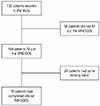1. Fader AN, Arriba LN, Frasure HE, von Gruenigen VE. Endometrial cancer and obesity: epidemiology, biomarkers, prevention and survivorship. Gynecol Oncol. 2009; 114:121–127.

2. Bellelis P, Podgaec S, Abrão MS. Fatores ambientais e endometriose. Rev Assoc Med Bras. 2011; 57:456–461.

3. Bulletti C, Coccia ME, Battistoni S, Borini A. Endometriosis and infertility. J Assist Reprod Genet. 2010; 27:441–447.

4. Mcleod BS, Retzloff MG. Epidemiology of endometriosis: an assessment of risk factors. Clin Obstet Gynecol. 2010; 53:389–396.
5. Gallagher JS, Feldman HA, Stokes NA, Laufer MR, Hornstein MD, Gordon CM, et al. The effects of GnRHa plus add-back therapy on quality of life for adolescents with endometriosis: a randomized controlled trial. J Pediatr Adolesc Gynecol. 2017; 30:215–222.
6. Santulli P, Bourdon M, Presse M, Gayet V, Marcellin L, Prunet C, et al. Endometriosis-related infertility: assisted reproductive technology has no adverse impact on pain or quality-of-life scores. Fertil Steril. 2016; 105:978–987.
7. van der Zanden M, Nap AW. Knowledge of, and treatment strategies for, endometriosis among general practitioners. Reprod Biomed Online. 2016; 32:527–531.

8. McPeak AE, Allaire C, Williams C, Albert A, Lisonkova S, Yong PJ. Pain catastrophizing and pain health-related quality-of-life in endometriosis. Clin J Pain. 2018; 34:349–356.

9. Ferreira AL, Bessa MM, Drezett J, de Abreu LC. Quality of life of the woman carrier of endometriosis: systematized review. Reprod Clim. 2016; 31:48–54.

10. Giuliani M, Cosmi V, Pierleoni L, Recine A, Pieroni M, Ticino A, et al. Quality of life and sexual satisfaction in women suffering from endometriosis: an Italian preliminary study. Sexologies. 2016; 25:e12–9.

11. Butrick CW. Patients with chronic pelvic pain: endometriosis or interstitial cystitis/painful bladder syndrome? JSLS. 2007; 11:182–189.
12. Koninckx PR, Meuleman C, Demeyere S, Lesaffre E, Cornillie FJ. Suggestive evidence that pelvic endometriosis is a progressive disease, whereas deeply infiltrating endometriosis is associated with pelvic pain. Fertil Steril. 1991; 55:759–765.

13. Freschi L, Simi G, Obino ME, Ruggiero M, Papini F, Cela V. Dienogest in the treatment of endometriosis: a retrospective analysis of quality of life. Gynecol Endocrinol. 2016; 32:107.
14. The World Health Organization Quality of Life Assessment (WHOQOL). development and general psychometric properties. Soc Sci Med. 1998; 46:1569–1585.
15. Gholami A, Araghi MT, Shamsabadi F, Bayat M, Dabirkhani F, Moradpour F, et al. Application of the World Health Organization Quality of Life Instrument, Short Form (WHOQOL-BREF) to patients with cataract. Epidemiol Health. 2016; 38:e2016005.

16. Taylor WJ, Myers J, Simpson RT, McPherson KM, Weatherall M. Quality of life of people with rheumatoid arthritis as measured by the World Health Organization Quality of Life Instrument, Short Form (WHOQOL-BREF): score distributions and psychometric properties. Arthritis Rheum. 2004; 51:350–357.

17. Nejat S, Montazeri A, Holakouie Naieni K, Mohammad K, Majdzadeh SR. The World Health Organization Quality of Life (WHOQOL-BREF) questionnaire: translation and validation study of the Iranian version. Majallah-i Danishkadah-i Bihdasht va Anstitu Tahqiqat-i Bihdashti. 2006; 4:1–12.
18. Mental Health Programme of WHO. WHOQOL-BREF: introduction, administration, scoring and generic version of the assessment. Geneva: Programme on Mental Health, World Health Organization;1996.
19. Skevington SM, Tucker C. Designing response scales for cross-cultural use in health care: data from the development of the UK WHOQOL. Br J Med Psychol. 1999; 72:51–61.

20. World Health Organization. WHOQOL user manual: programme on mental health. Geneva: World Health Organization;1998.
21. Bland JM, Altman DG. Statistics notes: Cronbach's alpha. BMJ. 1997; 314:572.

22. Nedjat S, Montazeri A, Holakouie K, Mohammad K, Majdzadeh R. Psychometric properties of the Iranian interview-administered version of the World Health Organization's Quality of Life Questionnaire (WHOQOL-BREF): a population-based study. BMC Health Serv Res. 2008; 8:61.

23. Nojomi M, Bijari B, Akhbari R, Kashanian M. The assessment of reliability and validity of Persian version of the endometriosis health profile (EHP-30). Iran J Med Sci. 2011; 36:84–89.
24. Fourquet J, Gao X, Zavala D, Orengo JC, Abac S, Ruiz A, et al. Patients' report on how endometriosis affects health, work, and daily life. Fertil Steril. 2010; 93:2424–2428.

25. Vercellini P, Frattaruolo M, Somigliana E, Jones G, Consonni D, Alberico D, et al. Surgical versus low-dose progestin treatment for endometriosis-associated severe deep dyspareunia II: effect on sexual functioning, psychological status and health-related quality of life. Hum Reprod. 2013; 28:1221–1230.

26. Fourquet J, Báez L, Figueroa M, Iriarte RI, Flores I. Quantification of the impact of endometriosis symptoms on health-related quality of life and work productivity. Fertil Steril. 2011; 96:107–112.

27. Denny E, Mann CH. Endometriosis-associated dyspareunia: the impact on women's lives. J Fam Plann Reprod Health Care. 2007; 33:189–193.

28. Nnoaham KE, Hummelshoj L, Webster P, d'Hooghe T, de Cicco Nardone F, de Cicco Nardone C, et al. Impact of endometriosis on quality of life and work productivity: a multicenter study across ten countries. Fertil Steril. 2011; 96:366–373.e8.

29. Jones G, Jenkinson C, Kennedy S. The impact of endometriosis upon quality of life: a qualitative analysis. J Psychosom Obstet Gynaecol. 2004; 25:123–133.

30. Dubernard G, Piketty M, Rouzier R, Houry S, Bazot M, Darai E. Quality of life after laparoscopic colorectal resection for endometriosis. Hum Reprod. 2006; 21:1243–1247.

31. Simoens S, Dunselman G, Dirksen C, Hummelshoj L, Bokor A, Brandes I, et al. The burden of endometriosis: costs and quality of life of women with endometriosis and treated in referral centres. Hum Reprod. 2012; 27:1292–1299.











 PDF
PDF ePub
ePub Citation
Citation Print
Print



 XML Download
XML Download